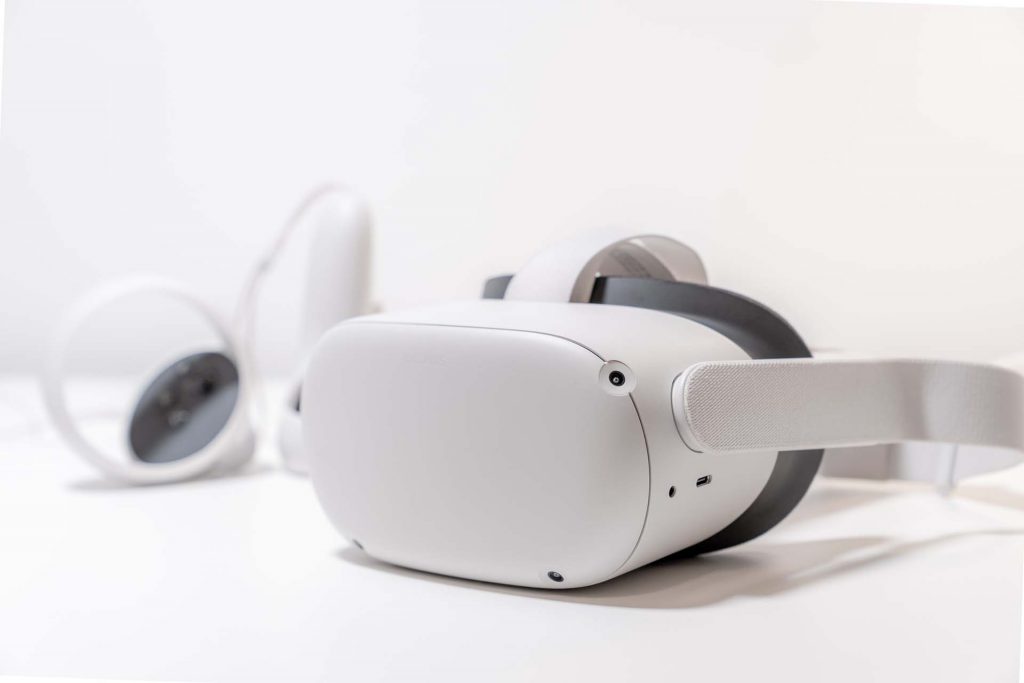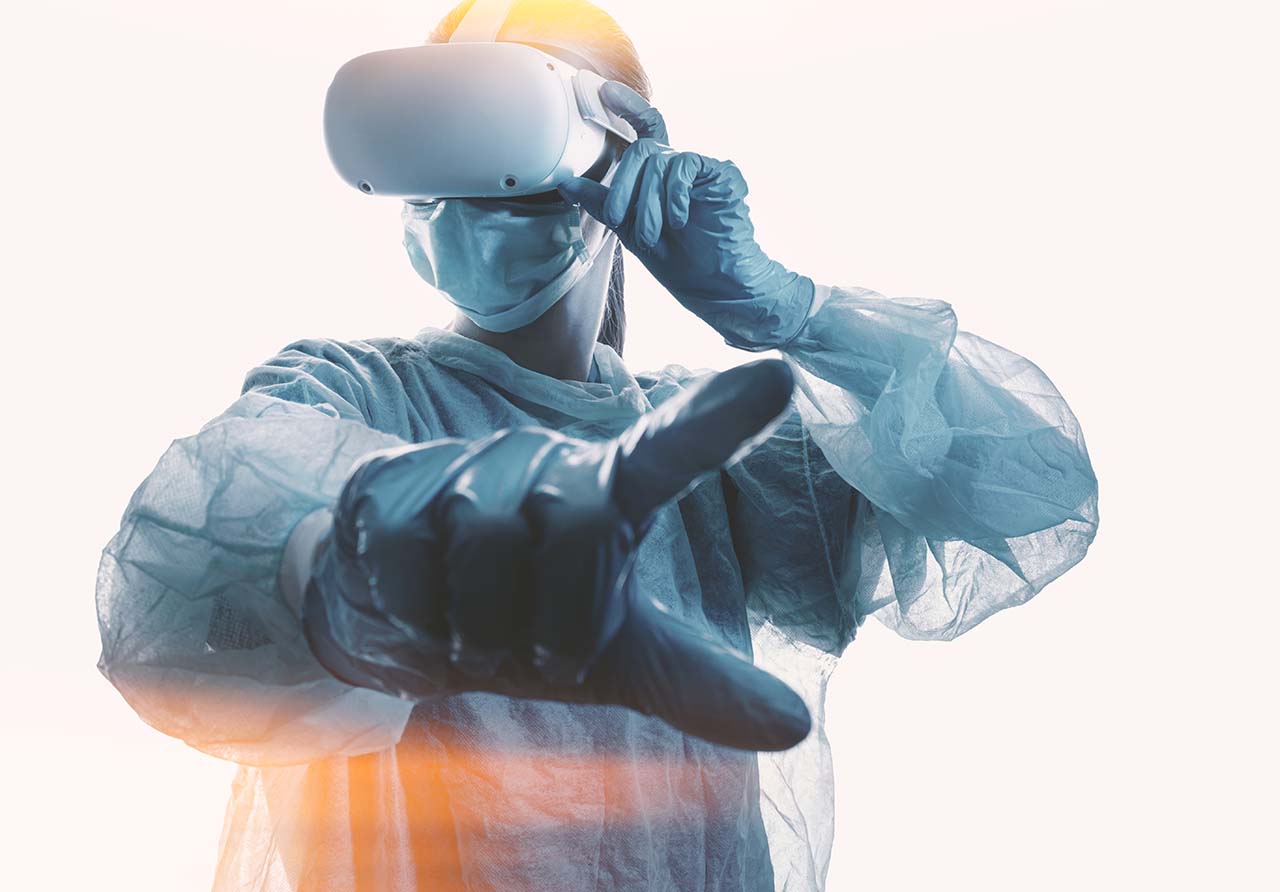Virtual reality between presence, immersiveness and interaction in ever greater degrees to simulate situations and actions in the medical field.
What is a Holodeck?
The holodeck is a science fiction technology from the Star Trek universe that allows you to recreate very realistic scenes with the help of force fields, projection systems and very sophisticated sound and visual reproduction techniques. A holodeck is capable of generating very faithful reproductions of life forms, composed of solid matter created through replicators based on teleportation technology and manipulated by high-precision tractor beams managed by the holodeck computer. The result is an extremely realistic figure that has a behavior very similar to a living being, whose limit is only that of the management software. This sci-fi dream is the goal that has been sought in recent years in the field of virtual reality. But let’s go back to the present.

What is Virtual Reality?
Virtual reality is a very lively field of research. The experience involves the complete immersion of the participant in a computer-recreated environment that makes the simulation almost indistinguishable from reality. This is achieved through helmets with special visors, gloves and overalls with sensors that detect the movement of the participants to integrate them into the virtual setting. All of this is integrated and produced in real time to allow for a realistic flow of the setting. One of the pioneers of Virtual Reality, Jaron Lanier, coined the oxymoron Virtual Reality in 1988, combining these two words of opposite meaning, to describe “a technology used to synthesize a shared reality… which has nothing to do directly with what is in the brain…but only with what our sensory organs perceive”. The fundamental properties of a virtual reality experience can be summarized in three main aspects: presence, immersion and interaction.
Presence is defined as the mental sensation of being in a virtual space (not necessarily synthetic – also applicable, for example, to books and films), which provides a measure of user involvement. Immersiveness which involves immersing oneself completely in the virtual world, on a sensorial level, through interfaces, which give a measure of the perception of the virtual world as existing. The interaction provides the possibility for the user to modify the environment and, on the part of the environment, to respond to the user’s actions, which gives a measure of the “realism” of the simulation. Each of these components is equally important in order to produce a compelling VR experience. The latter two are more closely related to technology and have been the subject of a considerable amount of study and research. The higher the quality, and the more sensory information there is, the higher the level of presence usually is; the control of the relationship between sensors and the environment, i.e. the degree of user ability to control and manipulate the sensors (for example linking the movements of the “camera” which frames the virtual world to the movements of the user’s head, so as to create visual exploration in the most natural way possible); the possibility of modifying the virtual environment: if users are able to act naturally in the environment, i.e. if they can perform actions that seem natural to them (move an object, open a door) and the behavior of the environment in response to their actions are what they would expect in the corresponding real world, the sense of presence is higher.
What does the international literature say?
We are obsessed with cardiac arrest and for this reason we could not forget to mention the use of virtual reality in cardiopulmonary resuscitation (CPR) training. Increasing the number of people educated and trained in CPR is of paramount importance to increase the number of cases in which CPR is started before the ambulance arrives and consequently survival after cardiac arrest. Classical training is based on the use of a manikin positioned inside a classroom. This type of training lacks realism as it is completely different from a real scenario in which bystanders could potentially find themselves intervening. For this reason, several innovative solutions for CPR training have been developed using digital technologies such as virtual reality and mobile applications. Since 2008, the Italian Resuscitation Council (IRC) has been a pioneer in the field of innovative strategies to raise awareness of cardiac arrest and teach how to intervene.
Imagining and predicting the future is a mental exercise and an interesting field of research. Our mission in this space will be to imagine the medicine and education of the future.
We will do it with irreverence and respect…
In a randomized study comparing two different digital CPR training modalities, a virtual reality app was found to improve bystanders’ intervention sequence compared to a standard video-only app (1). This improvement could be due to the high realism that Virtual Reality (VR) allows, fully immersing the participant in the scenario of a cardiac arrest. However, the depth of chest compressions was significantly reduced among VR users of the app. Another study that also used a VR app to train students showed that the quality of CPR was comparable to face-to-face training (2).
Virtual reality was also used to characterize bystander response and behavior in the face of unannounced cardiac arrest using an immersive system (3) The virtual scenario began with the participant immersed in a public environment with the ability to walk around the simulated environment and acclimate to the virtual environment for 30 seconds. Subsequently, the virtual victim collapsed while walking towards the participant. From this moment on, times and actions for every single link in the chain of survival were measured. Thanks to virtual reality it was possible to evaluate for the first time in a large sample of participants the response to an unannounced cardiac arrest in a public place. Although most subjects attempted CPR, the vast majority did not request an AED, and of those who did, the majority did not apply one.
In conclusion, the use of VR during CPR training can be comparable to traditional classroom methods. Most likely the truth lies somewhere in between and the real benefit of VR could be precisely in the complementarity with face-to-face training. Combining traditional training with VR can increase participant engagement, particularly in children and adolescents. In an international survey conducted by IRC in 2017, most instructors believed that VR could play a role in the future of training (4). The use of VR may be considered where resources or time do not allow for formal face-to-face training sessions or in combination with classical training. In addition, these new tools have the potential to raise awareness of cardiac arrest-related issues and reveal where to focus population education.
“The international literature is very promising in integrating VR into CPR training. Technological progress in VR as well as the integration of these technologies into everyday smartphones could foster the diffusion of these new forms of training, bringing a BLS course to every home. Like the introduction in 1965 of the famous game “The cheerful surgeon”, in a few years we will be able to see a gift package under the Christmas tree with a virtual reality BLS course inside”, said Tommaso “Bot” Scquizzato.
What are the future developments?
Virtual reality, to be honest, has a very old history and has experienced “historical courses and recurrences”. A previous generation remembers the trend of the virtual in videogames and cinema. It was 1992 when a very young Pierce Brosnan played a new Frankenstein, Dr. Angelo Lawrence, who, frustrated by the failure of his experiments, begins to experiment with a mentally retarded gardener by enhancing his mental abilities with virtual reality. Since 2015, virtual reality has made a comeback and there are those who predict that in 2040 reality will be indistinguishable from virtual reality. Will there be a virtual horizon indistinguishable from reality? What could change in training?
“Many years ago, the pioneers of medical training using low-fidelity simulators, called dummies at the time, were accused of playing with “dolls.” Today, low- and high-fidelity simulation has become the most widely used training tool in the world. Those who have been involved and are involved in virtual reality could in these “modern times” instead be accused of being a “fanatic” of video games or a geek. I personally have no difficulty imagining a formative 2030 exactly like a holodeck scenario. In virtual reality it will be possible to acquire knowledge with a simple documentary but with a very high level of immersion. It will be possible to potentially change the attitudes of learners through the use of highly immersive environments to “solicit” real emotions in the management of complex cases. Finally, it will be possible to teach and learn complex skills and interactions with the progress of motion capture which has become the “standard of care” in the film industry. Finally, much current research on the ability to build haptic devices that reproduce and close the loop of sensations will lead to an experience above expectations. I’d like to bet with all of you that this will happen and I’m sure I won’t lose the bet”, says Federico “Han Solo” Semeraro.
What do we have today to teach cardiopulmonary resuscitation in virtual reality?
The first attempt to apply virtual reality technologies to cardiopulmonary resuscitation dates back to 2008 (5) A proudly Italian collaborative project between the Italian Resuscitation Council and Scuola Superiore Sant’Anna (https://youtu.be/2muttEy-qcs). Since 2008, several research groups have used virtual reality to teach CPR. If you are curious go to PubMed and type “Virtual Reality and CPR” and you will find many experiences. In 2018 we experimented with Virtual Reality CPR producing training sessions with Oculus Go, HTC Vive allowing the participant to have blended knowledge experiences and CPR training stations with real time feedback on the maneuvers (https://youtu.be/ TzDzVq5M-7Q and https://youtu.be/naCk_k226pQ). Many in Europe and around the world have produced different models and prototypes of VR CPR and the use of VR applied to CPR. If you take a look on YouTube you will find many experiences (https://youtu.be/QuUavS3WSAI and https://youtu.be/Vq7k-Kg7ulo). The recent integration between Oculus and Facebook has certainly given an impressive acceleration to the use of virtual reality technologies. The recent release of Workrooms (https://www.oculus.com/workrooms/) will bring the possibility of interaction in a virtual environment into the homes of many social media fanatics. Are we condemned to end up on a cot like “The world of replicants” and live eternally in the fictitious world or will we make the most of the Virtual Reality potential?
Bibliography
- Leary M., McGovern S.K., Chaudhary Z., Patel J., Abella B.S., Blewer A.L., Comparing bystander response to a sudden cardiac arrest using a virtual reality CPR training mobile app versus a standard CPR training mobile app, Resuscitation, 2019 Jun;139:167-173. doi: 10.1016/j.resuscitation.2019.04.017. Epub 2019 Apr 18. PMID: 31005588.
- Yeung J., Kovic I., Vidacic M., et al., The school Lifesavers study — a randomised controlled trial comparing the impact of lifesaver only, face-to-face training only, and lifesaver with face-to-face training on CPR knowledge, skills and attitudes in UK school children, Resuscitation 2017;120:138–45.
- Leary M., Almodovar A. Jr, Buckler D.G., Bhardwaj A., Blewer A.L., Abella B.S., Using an Immersive Virtual Reality System to Assess Lay Provider Response to an Unannounced Simulated Sudden Cardiac Arrest in the Out-of-Hospital Setting, Simul Healthc. 2019 Apr;14(2):82-89. doi: 10.1097/SIH.0000000000000338. PMID: 30407959.
- Semeraro F., Scapigliati A., Ristagno G., Luciani A., Gandolfi S., Lockey A., Müller M.P., Wingen S., Böttiger B.W., Virtual Reality for CPR training: How cool is that? Dedicated to the “next generation”, Resuscitation. 2017 Dec;121:e1-e2. doi: 10.1016/j.resuscitation.2017.09.024. Epub 2017 Sep 23. PMID: 28951295.
- Semeraro F., Frisoli A., Bergamasco M., Cerchiari E.L., Virtual reality enhanced mannequin (VREM) that is well received by resuscitation experts, Resuscitation. 2009 Apr;80(4):489-92. doi: 10.1016/j.resuscitation.2008.12.016. Epub 2009 Feb 8. PMID: 19203823.































Leave a comment
You must be logged in to post a comment.